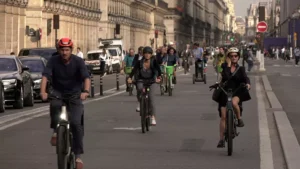E-Bike Safety Features Matter in Urban Environments
Urban cycling demands heightened awareness due to the complexity of city landscapes. E-bikes, with their heavier frames (often 55–60 pounds) and higher speeds (up to 28 mph for Class 3 models), require robust safety features to mitigate risks. According to the U.S. Consumer Product Safety Commission, e-bike-related injuries surged from 3,500 in 2017 to 24,400 in 2022, highlighting the need for enhanced safety measures. E-bike safety features for urban riding are essential for protecting riders from collisions, falls, and other hazards while ensuring compliance with local regulations.

The Risks of Urban E-Bike Riding
Urban settings pose several challenges:
- Traffic Density: Sharing roads with cars, buses, and trucks increases collision risks, especially at intersections.
- Pedestrian Interactions: Cyclists must navigate crowded sidewalks and crosswalks.
- Road Hazards: Potholes, wet surfaces, and debris can cause accidents, particularly on heavier e-bikes.
- Higher Speeds: Motor assistance amplifies speed, requiring precise control and braking.
The Role of Safety Features
E-bike safety features for urban riding enhance visibility, control, and stability. From advanced braking systems to integrated lighting, these technologies reduce accident risks and boost rider confidence. They also align with regulations, such as California’s helmet mandates for Class 3 e-bikes and clear class labeling requirements.
Key E-Bike Safety Features for Urban Riding
Modern e-bikes are equipped with a range of safety features tailored to urban conditions. Below, we detail the most critical e-bike safety features for urban riding, their benefits, and how they contribute to safer city commuting.
1. Advanced Braking Systems
E-bikes’ weight and speed necessitate powerful braking systems to ensure safe stops in urban traffic.
Hydraulic Disc Brakes
Hydraulic disc brakes offer superior stopping power compared to rim brakes, especially in wet conditions. They provide:
- Reliable Performance: Consistent braking force under heavy loads or high speeds.
- Quick Response: Essential for sudden stops at busy intersections.
- Low Maintenance: Durable design reduces wear and tear.
Brands like Rad Power Bikes feature hydraulic disc brakes as standard, ensuring reliable stopping power. Learn more about e-bike braking systems at Electric Bike Report.
Motor-Interrupt Brake Levers
Motor-interrupt brake levers cut off the motor when brakes are applied, preventing unintended acceleration. This feature is vital for:
- Emergency Situations: Ensures the motor doesn’t counteract braking efforts.
- Control in Traffic: Reduces rear-end collision risks by stopping power delivery instantly.
2. Integrated Lighting Systems
Visibility is critical in urban settings, where low-light conditions increase accident risks. Integrated lighting is a cornerstone of e-bike safety features for urban riding.
Front and Rear Lights
High-quality e-bikes include built-in front white lights and rear red LED lights with multiple modes. These lights:
- Enhance Visibility: Ensure riders are seen from at least half a mile away.
- Comply with Regulations: Meet requirements in states like California for night-time reflective equipment.
- Improve Safety: Reduce collision risks at intersections and in low-visibility conditions.
Brake Lights
Some e-bikes, like those from Qiolor, feature brake lights that activate when slowing down, alerting other road users and reducing rear-end collision risks.
3. Reflective and Puncture-Resistant Tires
Tires are crucial for safety on urban roads with debris, potholes, and uneven surfaces.
Puncture-Resistant Tires
Puncture-resistant tires, such as the Continental City Contact Plus E50, minimize flats, which can be dangerous in traffic. Benefits include:
- Durability: Withstand glass, nails, and other urban hazards.
- Stability: Maintain traction on wet or uneven surfaces.
- Peace of Mind: Reduce the risk of being stranded in unsafe areas.
Reflective Sidewalls
Tires with reflective sidewalls enhance nighttime visibility, making riders more noticeable to drivers.
4. Anti-Lock Braking Systems (ABS)
Bosch’s e-bike ABS, introduced in 2020, prevents wheel lockup during braking, ensuring:
- Stability During Emergency Stops: Keeps the rear wheel grounded, reducing skids.
- Control on Mixed Surfaces: Ideal for cities with changing road conditions.
- Enhanced Safety for Cargo Bikes: The ABS Cargo function supports heavy loads, common in urban delivery scenarios.
5. Warning Devices
Audible warning devices, such as horns or bells, alert pedestrians and drivers in crowded areas.
- Air Horns: Loud devices like the AirZound can alert distracted drivers, preventing collisions.
- Bells: Gentler options for notifying pedestrians on shared paths.
6. Ergonomic and Commute-Friendly Design
Urban e-bikes prioritize comfort and control, reducing fatigue and improving safety.
- Upright Riding Position: Enhances visibility and reduces strain on the back and wrists.
- Adjustable Handlebars and Saddles: Improve control in tight spaces.
- Step-Thru Frames: Facilitate easy mounting and dismounting for frequent stops.
7. Battery Safety Features
Lithium-ion battery fires, with 267 incidents reported in New York City in 2023, highlight the need for safe battery systems.
- UL-Certified Batteries: Ensure compliance with safety standards, reducing fire risks.
- Detachable Batteries: Allow safe charging away from heat sources, as recommended by the NFPA.
- No Overnight Charging: Prevents overcharging, a common cause of fires.
For detailed battery safety tips, visit People for Bikes.
Practical Tips for Safe Urban E-Bike Riding
While e-bike safety features for urban riding provide a strong foundation, rider behavior is equally important. Here are actionable tips to enhance safety:
Wear Protective Gear
- Helmets: Choose helmets with MIPS for enhanced protection. Helmets are mandatory for Class 3 e-bike riders in California.
- Reflective Clothing: Wear bright or reflective vests to increase visibility.
- Protective Pads: Consider elbow and knee pads for high-speed rides.
Follow Traffic Rules
E-bikes are subject to bicycle traffic laws in most U.S. states. Key rules include:
- Ride in Bike Lanes: Use designated lanes unless avoiding hazards.
- Obey Signals: Stop at red lights and use hand signals for turns.
- Avoid Sidewalks: Dismount in pedestrian areas to prevent collisions.
Practice Defensive Riding
- Assume Invisibility: Assume drivers may not see you, especially at intersections.
- Use Mirrors or Radar: Equip your e-bike with a rearview mirror or Garmin Varia radar for awareness.
- Plan Safer Routes: Use apps like Google Maps’ bicycle mode for low-traffic routes.
Maintain Your E-Bike
- Regular Checks: Inspect tires, brakes, and lights before each ride.
- Battery Care: Avoid overcharging and store batteries at room temperature.
- Professional Servicing: Schedule maintenance at a bike shop for complex repairs.
Understand Your E-Bike
- Practice in Safe Areas: Test handling, braking, and acceleration in an empty lot.
- Know Your Class: Understand your e-bike’s classification (Class 1, 2, or 3) to comply with local laws.
Choosing an E-Bike with Safety in Mind
When selecting an e-bike for urban riding in 2025, prioritize models with robust safety features:
- Motor Power: Opt for 500W–750W motors for city commuting.
- Battery Range: Choose a 48V 14Ah battery for 35–65 miles of range.
- Safety Features: Look for hydraulic disc brakes, integrated lights, motor-interrupt levers, and UL-certified batteries.
- Comfort Features: Select ergonomic saddles, adjustable handlebars, and step-thru frames.
Recommended models include:
- Aventon Level.3: Features hydraulic disc brakes, integrated lights, and an electronic wheel lock.
- ENGWE E26: Offers all-terrain tires and a 250W motor for urban streets.
Explore more options at Bicycling for expert reviews.
Regulatory Considerations for Urban E-Bike Safety
E-bike regulations vary by region, impacting how safety features are utilized:
- California: Requires helmets for Class 3 riders and bans children under 12 from operating e-bikes starting in 2025.
- New York City: Prohibits e-bikes on sidewalks and mandates UL-certified batteries.
- Federal Guidelines: Class 1 (pedal-assist, 20 mph), Class 2 (throttle-assist, 20 mph), and Class 3 (pedal-assist, 28 mph) influence where e-bikes can be ridden.
Check local laws to avoid fines or confiscation. Resources like Movcan Bike provide detailed guides on U.S. e-bike regulations.
Conclusion
E-bike safety features for urban riding are vital for navigating the challenges of city environments in 2025. Hydraulic disc brakes, integrated lights, ABS, and UL-certified batteries enhance control, visibility, and security. By combining these features with defensive riding, proper gear, and regular maintenance, cyclists can enjoy safe and sustainable commuting. Explore trusted resources like Electric Bike Report and People for Bikes to stay informed about e-bike safety and regulations.



